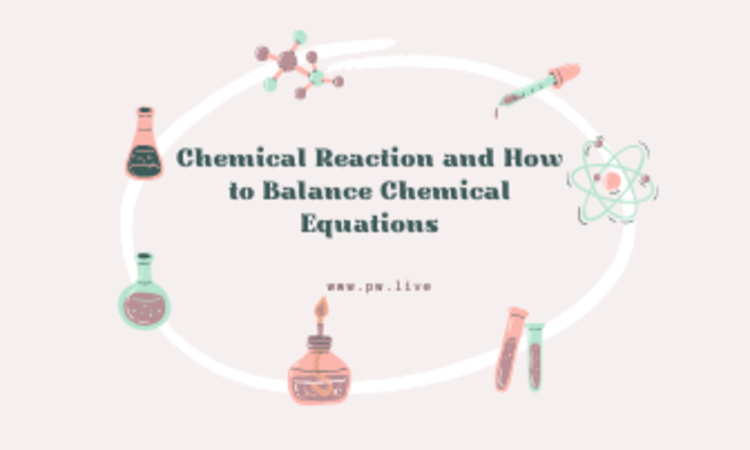Simply put, a chemical equation tells what happens in a chemical reaction. The chemical equation is:
Fe + O2 → Fe2O3
The substance is on the left side of the equation. These are the materials that initiate a chemical reaction.
The product is on the right side of the equation. A product is a substance formed as a result of a chemical reaction.
What Do You Understand by a Chemical Reaction?
A chemical equation is a written description of what happens in a chemical reaction. Starting materials, called reagents, are listed on the left side of the equation. Next comes an arrow that indicates the direction of the response. The substances are written on the right side of the reaction, called the product.
Chemical equations describe the changes that occur during a chemical reaction. The general chemical equation is:
Reagent → Product
An example of a simple chemical reaction is the combination of Hydrogen (H2) and oxygen (O2) to form water (H2O). The reactants are Hydrogen and oxygen in this reaction, and the product is water. To write a chemical equation for this reaction, you must start by writing the reactants on the left and the products on the right with arrows between them to indicate the reaction’s direction.
H2 + O2 → H2O
Look closely at the above equation. You will find there is something wrong with it. You must balance all the chemical equations. This means that there must be an equal number of atoms on either side of the arrow. This is because chemical equations always conserve mass.
Writing Chemical Equations
In this article, we are discussing two quick and easy methods to balance chemical reactions. The first method is the traditional chemical equation balancing method, and the second is an algebraic method.
The Traditional Balancing Method
Step 1: Write Down the given equation
C3H8 + O2 → CO2 + H2O
Step 2: We need to compare each element’s total number of atoms on the reactant and product sides. In this example, the number of atoms on each side can count as follows:
In chemical equation C3H8 + O2 → CO2 + H2O on the reactant side, we have
- 3 Carbon atoms
- 8 Hydrogen atoms
- 2 Oxygen atoms
On the product side, we have:
- 1 Carbon atom from CO2
- 2 Hydrogen atoms
- 3 Oxygen atoms, two from CO2 and one from H2O
Step 3: Save oxygen and Hydrogen for the last
Both oxygen and Hydrogen are ordinary in molecules. So it’s most likely on both sides of the equation because it’s best to balance it at the end. Also, atoms need to be recalculated to balance oxygen and Hydrogen, probably because you will have to use one element to balance the other atoms.
Step 4: Begin with the single element
First, if you need to balance more than one element, choose the elements that appear in one molecule of reactant and one molecule of product. In this case, you must first balance the carbon atoms.
Step 5: Use coefficients to balance the carbon atom
To do this, add one coefficient with one carbon on the right side of the equation to balance it with the three carbons on the left side of the equation.
You can see that three carbons on each side make up the carbon atom in equilibrium. However, you can change the coefficients in chemical equations but not the subscripts.
C3H8 + O2 → 3CO2 + H2O
Step 6: Now balance the Hydrogen
As you know, we have to balance all the atoms, so next balance hydrogen. Since there are eight hydrogens on the left side and only 2 on the right, we already have a subscript of 2 before the Hydrogen, so we use the coefficient to add a factor of 4 before the Hydrogen to balance the Hydrogen. Hence there should be eight hydrogen atoms on both sides. When you multiply 4 with the subscript two, you will get:
C3H8 + O2 → 3CO2 + 4H2O
Step 7: Balancing Oxygen
Usually, the coefficient is multiplied by the exponent. So on the right, there are ten oxygen atoms (3CO2→3×2=6 + 4atoms from4H2O). So we need to add eight more atoms to the left to balance it out.
To do this, add a factor of 5 to the oxygen molecule to get 10 (5 × 2 = 10).
C3H8 + 5O2 → 3CO2 + 4H2O
Both sides have the same number of carbon, hydrogen, and oxygen atoms. So the equation is complete. You can check out Ncert solution for class 12 chemistry to know more about chemical reactions.
Type 2 – Complement Algebraic Balance
The Algebraic balance method or the Bottomley method is very useful for complex reactions but takes a little more time.
1. Write down the equation
Write down the unbalanced chemical equation as it is.
C6H12O6 + O2 → CO2 + H2O
2. Assign alphabetical characters to each substance
Each species is assigned an algebraic (stoichiometric coefficient) in the unbalanced chemical equation. In this example, you can write the equation as
aC6H12O6 + bO2 → cCO2 + dH2O
Now we need to formulate a set of equations (between reactants and products) to balance each reaction element.
3. Check the numbers
Make sure the elements are on both sides and set them equal to each other. In this example, the system of equations is:
6a = c (for carbon),
6a = d (for hydrogen)
6a + 2b = 2c + d (for oxygen)
This system of equations can have multiple solutions, but it needs the solution with the smallest value of the variable. One of the coefficients is assigned a value to get this solution. In this case, the assumed value is 1.
a = 1
c = 6a = 6*1 = 6
d = 6a = 6
Substituting the values of a, c, and d into the equation 6a + 2b = 2c + d, the value of “b” can be obtained as
6*1 + 2b = 2*6 +6
2b = 12; b = 6
It is important to note that these equations must be solved so that each variable is a positive integer. Once you get a fractional value, you need to multiply each variable by the least common denominator between all the variables. This is necessary because the variable contains stoichiometric coefficient values , which must be positive integers.
4. Now that we have the smallest value for each variable, we can substitute that value into the chemical equation obtained in step 2
aC6H12O6 + bO2 → cCO2 + dH2O this equation transformed into
C6H12O6 + 6O2 → 6CO2 + 6H2O
It is a way to obtain a balanced chemical equation.
The algebraic equation method is more efficient than the traditional method. However, it can give a fractional value of the stoichiometric coefficient, which must convert into an integer.
While writing the reaction mechanism, you can download the chemistry formulas pdf with all the frequently required instructions.

